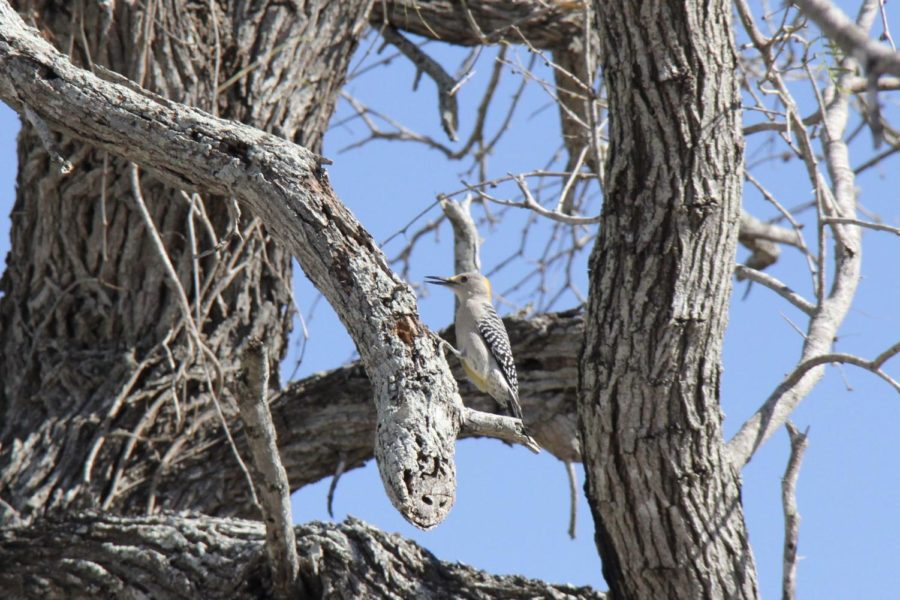Wildlife of South Texas
There is much beauty hidden behind South Texas’s hot weather and flat country plains. In a recent trip I took to Kingsville, I was able to capture images of many unique birds and wildlife, all of which I have identified (to the best of my ability) and now have the privilege to display to the Wrangler.
February 17, 2022
White Tailed Hawk: The White-Tailed Hawk is native to South Coastal Texas and many parts of Mexico and South America living on grassy flat areas while preying on small mammals including mice and other small birds. This hawk’s one defining feature is their clean black band on its tail feathers.
Red tailed Hawk: The Red-Tailed Hawk enjoys woodland areas and lives all over North America from Canada to Mexico and even Cuba. They can be seen soaring, their actual flying behavior, over open areas in search of small animals for food. These hawks are very common in North America and can be identified by their spotty, black belly band.
Meadowlark: These songbirds have a brilliant, bright yellow belly and a black triangle of feathers underneath their head. They also have a beige and black spotted back. Meadowlarks are often mistaken for the common mourning dove despite their very distinctive features. They are native to eastern North and South America; however, they are a protected species due to their declining population.
Golden-Fronted Woodpecker: This woodpecker is native to a small portion of south and central Texas as well as many parts of Mexico and can be identified by its black with white striped back and bright yellow feathers on the back of its head; male Golden-Fronted Woodpeckers can also be seen with a splotch of red on top of its head. These birds have a very distinct drumming sound as it hits tree wood with its beak, hence its name woodpecker.
Pyrrhuloxia: Pyrrhuloxias are a member of the cardinal family and often can be easily confused for a female Northern Cardinal. The Pyrrhuloxia and Northern Female cardinal share many similarities such as their brown body color, red feathers on their wing, tail and crest, tuff of feathers on top of their head, tips, and body shape and size. One distinctive feature of these birds is their bright yellow beak while the Northern Cardinal has an orange beak. These birds are native to southern parts of North America and many parts of Northern Mexico.
Ring Neck Dove: The Ring-Neck dove, or Eurasian Collared-Dove, is an invasive species, inhabiting parts all over the US and Mexico. These birds endanger the native mourning dove population by pushing them out of their habitat. In fact, because the Ring-Neck dove is invasive, they are unprotected and can be hunted all year round. The Ring-Neck dove has a very distinctive black band of feathers around the back of its neck, hence its name.
Mockingbird: As Texas’ state bird, the Mockingbird is prevalent all-over North America from the US to Cuba. The Mockingbird gets its name from its singing behavior as it copies, or mocks, other birds’ calls to keep other birds out of their territory. These ground-foraging birds have a gray body with black and white wings, and they are very common in residential neighborhoods.
Loggerhead shrike: The Loggerhead Shrike is a small songbird native to parts of the US ad Mexico. However, these birds are in steep decline and aren’t seen often; conservation efforts are in place in an attempt to help the shrike population. The Loggerhead Shrike has a gray body with a defining black stripe over its eye like a racoon has, and it has black feathers on its tails and wing tips.
Black Buck: Brought here from South Asia, the Black Buck is an antelope breed with brilliantly shaped horns spiraling upwards from its head. Unlike the common white tail deer, the Black Buck has horns instead of antlers, meaning their horns do not shed. A female Black Buck is lighter in color compared to a male and has short horns rather than the curly, long horns. These antelopes were first released into Texas in 1932 and are primarily found in South Texas private ranches.
White tail deer: Native to parts all over Texas and beyond, the White Tail Deer is one of the most populous deer species in Texas and can even be seen residential neighborhoods. There are about four million of these deer here, making it the largest White Tail Deer population in the country. These deer grow tined antlers that can be as big as 10-12 points or as small as four points. White Tail Deer get their name from their tail which has a fluffy white bottom that can be seen while the deer runs.




